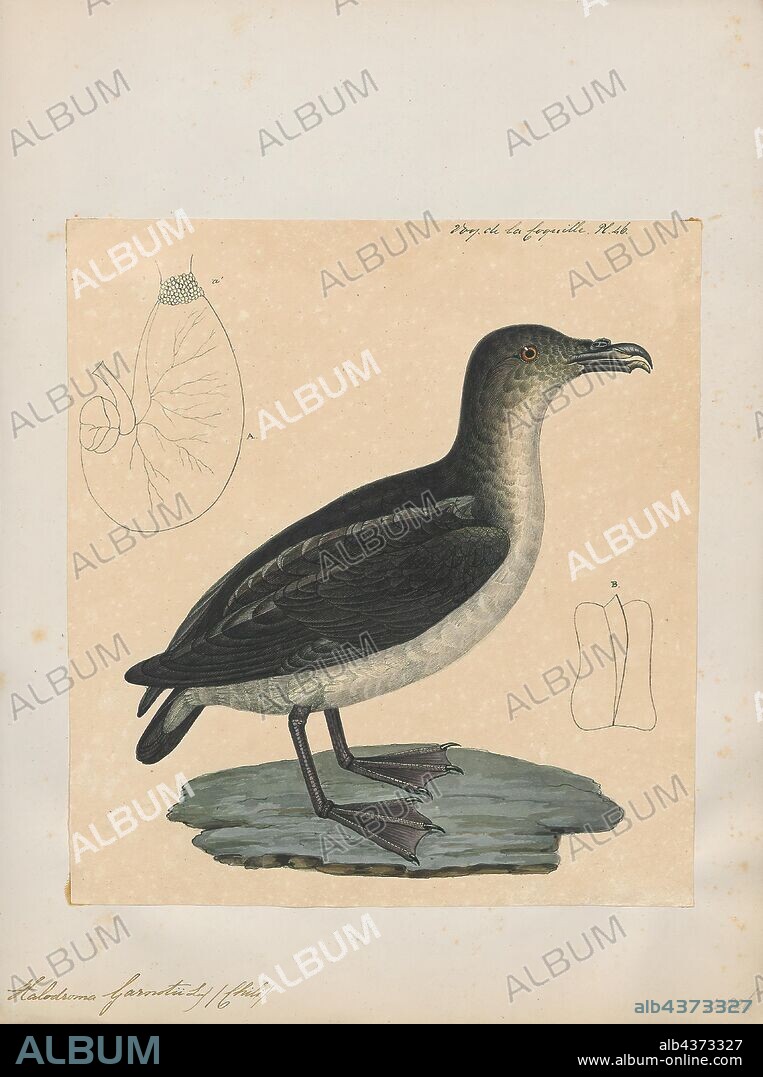alb4373327
Pelecanoides garnotii, Print, The Peruvian diving petrel (Pelecanoides garnotii) (local name in Peru: potoyunco), is a small seabird that feeds in offshore waters in the Humboldt Current off Peru and Chile. Like the rest of the diving petrels it is a nondescript bird, with a dark back and pale belly, and blue feet, and can be separated from the rest of its family only by differences in its beak and nostrils. Unlike the common diving petrel and the South Georgia diving petrel it feeds in cold, offshore, often pelagic water, obtaining small fish larvae and planktonic crustaceans by pursuit diving. The main part of his food is made up by plankton organisms (85.3-91.1%). The remaining percentage of the Peruvian diving petrels food is fish, mainly anchovies. Peruvian diving petrels can dive up to 83 metres (270 ft) deep but the average depth was recorded at around 30 metres (100 ft). It was long thought that the Peruvian diving petrel was rather bad in flying. However, great numbers of birds have been observed fishing regularly in the area between Asia Island and Pachacamac Island at a distance of 150-200 kilometres north of their Peruvian breeding grounds., 1825-1838.

|
Add to another lightbox |
|
Add to another lightbox |



Caption:
Pelecanoides garnotii, Print, The Peruvian diving petrel (Pelecanoides garnotii) (local name in Peru: potoyunco), is a small seabird that feeds in offshore waters in the Humboldt Current off Peru and Chile. Like the rest of the diving petrels it is a nondescript bird, with a dark back and pale belly, and blue feet, and can be separated from the rest of its family only by differences in its beak and nostrils. Unlike the common diving petrel and the South Georgia diving petrel it feeds in cold, offshore, often pelagic water, obtaining small fish larvae and planktonic crustaceans by pursuit diving. The main part of his food is made up by plankton organisms (85.3-91.1%). The remaining percentage of the Peruvian diving petrels food is fish, mainly anchovies. Peruvian diving petrels can dive up to 83 metres (270 ft) deep but the average depth was recorded at around 30 metres (100 ft). It was long thought that the Peruvian diving petrel was rather bad in flying. However, great numbers of birds have been observed fishing regularly in the area between Asia Island and Pachacamac Island at a distance of 150-200 kilometres north of their Peruvian breeding grounds., 1825-1838
Credit:
Album / quintlox
Releases:
Model: No - Property: No
Rights questions?
Rights questions?
Image size:
3440 x 4616 px | 45.4 MB
Print size:
29.1 x 39.1 cm | 11.5 x 15.4 in (300 dpi)
Keywords:
100 FT • 150-200 KILOMETRES NORTH • 1825-1838 • 270 FT • 30 METRES • 83 METRES • 85.3-91.1% • AREA • ASIA ISLAND • AVERAGE DEPTH • BAD • BEAK • BIRDS • BLUE FEET • CHILE • COLD • COMMON DIVING PETREL • DARK BACK • DEEP • DIFFERENCES • DISTANCE • DIVE UP • DIVING PETRELS • FAMILIAR • FAMILY • FEEDS • FISH • FLYING • FOOD • FOODSTUFFS • GREAT NUMBERS • HUMBOLDT CURRENT OFF PERU • LOCAL NAME • LONG THOUGHT • MAIN PART • MAINLY ANCHOVIES • NONDESCRIPT BIRD • NOSTRILS • OBSERVED FISHING REGULARLY • OBTAINING SMALL FISH LARVAE • OFFSHORE WATERS • OFFSHORE • PACHACAMAC ISLAND • PALE BELLY • PELAGIC WATER • PELECANOIDES GARNOTII • PERU • PERUVIAN BREEDING GROUNDS • PERUVIAN DIVING PETREL • PERUVIAN DIVING PETRELS FOOD • PERUVIAN DIVING PETRELS • PLANKTON ORGANISMS • PLANKTONIC CRUSTACEANS • POTOYUNCO • PRINT • PURSUIT DIVING • RECORDED • REMAINING PERCENTAGE • REST • SEPARATED • SMALL SEABIRD • SOUTH GEORGIA DIVING PETREL • UP
 Pinterest
Pinterest Twitter
Twitter Facebook
Facebook Copy link
Copy link Email
Email

